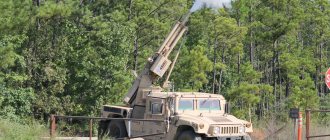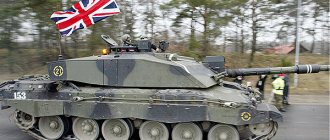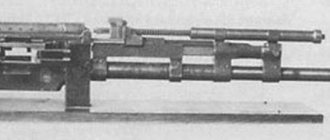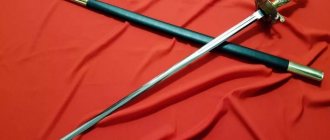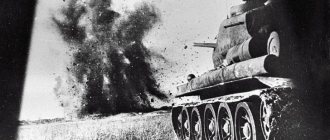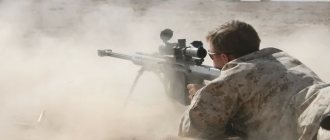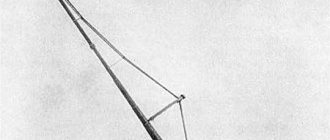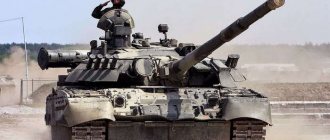The advent of hand-held grenade launchers, and then guided anti-tank missiles, marked the beginning of a new era in the epic confrontation between infantry and armored vehicles. The soldier on the battlefield finally had a light and inexpensive weapon with which he could single-handedly take out an enemy tank. It would seem that the time of anti-tank artillery has passed forever and the only suitable place for anti-tank guns is a museum exhibition or, in extreme cases, a conservation warehouse. But as you know, every rule has its exceptions.
The Soviet 100-mm anti-tank gun MT-12 was developed back in the late 60s, and despite this, it is still in service with the Russian army. The Rapier is a modernization of the earlier Soviet T-12 anti-tank gun, which consisted of placing the gun on a new carriage. This weapon is used not only by the Russian Armed Forces; it is currently in service in almost all armies of the former republics of the Soviet Union. Moreover, we are not talking about single copies: at the beginning of 2016, the Russian army had 526 MT-12 anti-tank guns in service, and more than 2 thousand more guns were in storage.
Serial production of the "Rapier" was established at the Yurginsky Machine Plant; it began in 1970.
The main task of the MT-12 is to fight enemy armored vehicles, so the main way to use this weapon is direct fire. However, the Rapier can also be fired from closed positions; for this purpose, the gun is equipped with special sighting devices. The gun can fire sub-caliber, cumulative and high-explosive fragmentation ammunition, as well as use guided anti-tank missiles for firing.
Based on the MT-12, the Kastet and Ruta complexes were developed. There is also a Yugoslav modification of the gun, the main feature of which is the use of a carriage from the D-30 howitzer.
For many decades, the MT-12 was actively exported. This gun was in service with almost all countries participating in the Warsaw Pact, as well as the armies of states that were considered allies of the USSR. The Rapier was used by Soviet troops during the war in Afghanistan; outposts and checkpoints were usually armed with these guns. After the collapse of the USSR, the MT-12 was actively used in numerous conflicts (Transnistria, Chechnya, Karabakh) that arose on its territory.
MT-12 Rapier gun. Firing range. Story. Dimensions
Currently, towed anti-tank guns are a relative rarity, and most of these weapons are in service with the armies of the republics of the former Soviet Union. Some former Warsaw Pact member states also retain a significant number of 100 mm T-12 (also known as 2A19) and MT-12 (modernized version) anti-tank guns. The T-12 was put into service in the mid-50s. As a result of operation, the need to make minor changes to the design of the carriage was revealed, and in 1972 an improved modification of the MT-12 appeared.
Operators[edit]
- Azerbaijan - 72 MT-12, as of 2022.
- Armenia - 36 MT-12, as of 2016.
- Bulgaria - 126 MT-12, as of 2016.
- Kazakhstan - 68 T-12/MT-12, as of 2016.
- Kyrgyzstan - 18 T-12/MT-12, as of 2016.
- Moldova - 37 MT-12, as of 2016.
- Mongolia - some, as of 2016.
- Russia - 526 MT-12, (2000 T-12/MT-12 in storage), as of January 2016.
- Turkmenistan - 60 T-12/MT-12, as of 2016.
- Uzbekistan - 36 T-12/MT-12, as of 2016.
- Ukraine - at least 500 T-12/MT-12, as of 2016.
Former[edit]
- Algeria - 10 T-12, as of 2010.
- Bosnia and Herzegovina - 155 T-12/MT-12, as of 2013.
- Hungary
- Germany ( GDR
) - Iraq
- Poland
- Russia ( USSR
) - Serbia ( Yugoslavia
) - Croatia - 133 T-12, as of 2010.
- Montenegro - 36 MT-12, as of 2010.
Anti-tank gun MT-12 Rapier - video
The T-12 and MT-12 guns have the same warhead - a long thin barrel 60 calibers long with a salt shaker muzzle brake.” The sliding beds are equipped with an additional retractable wheel installed at the openers. The main difference of the modernized MT-12 model is that it is equipped with a torsion bar suspension, which is locked when firing to ensure stability.
Although the T-12/MT-12 gun is designed primarily for direct fire, it is equipped with an additional panoramic sight and can be used as a regular field gun for firing high-explosive ammunition from indirect positions.
To combat armored targets, an armor-piercing sub-caliber projectile is used with a swept warhead, which has high kinetic energy and is capable of penetrating 215 mm thick armor at a distance of 1000 meters. Such ammunition is usually associated with tank guns, but the T-12 and MT-12 use single-loading shells that are different from the ammunition of the 100 mm D-10 tank gun installed on the T-54 and T-55 family of tanks. Also, the T-12/MT-12 cannon can fire cumulative anti-tank shells and 9M117 “Kastet” ATGMs, guided by a laser beam.
One of the modifications of the T-12 was produced in the former Yugoslavia: a 100 mm barrel was installed on the carriage of a 122 mm D-30 howitzer. This modification was designated "TOPAZ".
Modifications
MT-12K (2A29K) - In 1981, the 9K116 “Kastet” anti-tank missile system was adopted by the USSR ground forces (Tula KBP headed by A.G. Shipunov), designed to destroy armored vehicles, as well as small targets. The “Kastet” complex consists of a ZUBK10 shot with a 9M117 guided missile and 9Sh135 aiming and guidance equipment. The control system is semi-automatic using a laser beam. AK "Tulamashzavod" has mastered serial production of the modernized 9M117M "Kan" ATGM missile as part of the 3UBK10M round with a tandem cumulative warhead capable of penetrating the armor of tanks equipped with dynamic protection.
MT-12R (2A29R) - The MT-12R, “Ruta” complex was adopted for service and put into serial production in 1981. The all-weather radar sighting system 1A31, code "Ruta", installed on the MT-12 anti-tank gun, was created in 1980 at the Design Bureau of the Strela Research Institute (Chief Designer V. I. Simachev). The production of the 1A31 sight was carried out in 1981-1990.
M87 TOPAZ - Yugoslav modification of the MT-12. The main feature is the use of a carriage from the D-30 howitzer. The OMS also includes a laser rangefinder with a range from 200 to 9995 meters.
Construction[edit]
Structurally, the gun is a smooth-bore anti-tank gun on a classic two-frame carriage.
Gun barrel[edit]
The gun barrel consists of a 100-mm smooth-walled monoblock tube with a muzzle brake, breech and clip.
Sights[edit]
The following artillery sights are installed on the MT-12:
- For direct fire in the daytime (at a visible target) - an OP4MU-40U optical sight, which is removed from the gun only before long and difficult marches or during long-term storage;
- For firing from closed positions (at an invisible target) - mechanical sight S71-40 with a PG-1M panorama and a K-1 collimator;
- For night shooting - 1PN35, night sight APN-6-40 "Brusnika"; or 1PN53, night sight APN-7.
The PG-1M panorama is an optical device that is necessary for accurately aiming a gun at a target in horizontal and vertical planes.
The K-1 collimator is an optical device designed for horizontal aiming of a gun in the absence of natural aiming points or in conditions of poor visibility (in fog, snowfall, smoke in the firing position).
The Luch-S71M lighting device is also used to illuminate the gun sights at night.
Transportation[edit]
Since the MT-12 uses wheels from a ZIS-150 truck with a “GK” tire (sponge rubber - size 9.0-20, model Y-37), transportation was carried out by towing with an MT-L (MT-LB) crawler tractor , tractor-trailers Ural-375D and Ural-4320. When driving on snow, the LO-12 ski rig was used.
Performance characteristics of MT-12 Rapier
— Years of production: since 1970 — Crew, people: 6—7
Caliber MT-12 Rapier
— 100 mm
Overall dimensions of MT-12 Rapier
— Barrel length, bulb: 63 — Charging chamber length, mm: 915 — Gun width (by wheel caps), mm: 2320 — Stroke width, mm: 920 — Ground clearance, mm: 330 — Wheel diameter, mm: 1034 — Height line of fire, mm: 810 — Height of the gun in firing position at the highest elevation angle, mm: 2600 — Height of the gun along the upper cut of the shield, mm: 1600 — Angle of horizontal fire, degrees: 53-54 — Maximum angle of elevation, degrees: 20± 1 — Maximum angle of descent, degrees: −6—7 — Normal rollback length, mm: 680–770 — Maximum rollback length, mm: 780
Weight of MT-12 Rapier
— Weight of the gun in combat and stowed positions, kg: 3100 — Weight of the barrel with bolt, kg: 1337 — Weight of the assembled wedge, kg: 55 — Weight of rolling parts, kg: 1420
Firing range of MT-12 Rapier
— High-explosive fragmentation projectile: 8200 m (mounted fire) — Armor-piercing sabot projectile: 3000 m — Cumulative projectile: 5955 m
— Rate of fire, rds/min: 6—14 — Initial projectile speed, m/s: 1575 (sub-caliber); 975 (cumulative) - Projectile mass, kg: 5.65 (sub-caliber); 4.69 kg (cumulative) - Sight: APN-6-40, OP4M-40U.
Content
- 1 Development history
- 2 Serial production
- 3 Design 3.1 Gun barrel
- 3.2 Sights
- 3.3 Transport
- 4.1 Armor-piercing sabot shells (APS)
- 7.1 Exes
Photo MT-12 Rapier
Similar
SAU 2S7 Pion (2S7M Malka) performance characteristics. Caliber. Dimensions. Firing range
MLRS BM-21 Grad. Damage area. Rockets. Caliber. Story
120-mm mortar 2B11 complex 2S12 Sani TTX. Firing range. Weight
Mortar 2B9M Vasilek 82 mm Rate of fire. Firing range. Weight
Self-propelled gun 2S3 Akatsiya 152 mm. Firing range. Dimensions. Weight. Engine
SAU 2S1 Gvozdika 122 mm Firing range. Dimensions. Device. Weight
Gun 2A36 Giatsint-B 152 mm. Firing range. Dimensions. Device
MLRS 9K58 Smerch Damage area. Rockets. Caliber. Story
MT-12 Rapier gun. Firing range. Story. Dimensions
Howitzer D-30 122-mm performance characteristics. Firing range. Dimensions. Weight
2S4 Tulip self-propelled mortar 240 mm performance characteristics. Dimensions. Firing range. Weight
Self-propelled gun 2S35 Koalitsiya-SV 152-mm performance characteristics. Firing range. Dimensions. Weight
Howitzer Msta-B (2A65) 152 mm. Firing range. Dimensions. Weight. Ammunition
Self-propelled gun 2S9 Nona-S 120 mm performance characteristics. Firing range. Dimensions. Weight. Armament
AT-T heavy artillery tractor. TTX. Dimensions. Engine. Story
SAU 2S19 Msta-S 152 mm Dimensions. Speed. Engine. Story
MLRS 9K57 Hurricane Damage area. Rockets. Caliber. Story
TOS-1 Buratino (TOS-1A Solntsepek) performance characteristics. Damage area
Divisional gun ZIS-3 76 mm. TTX. Firing range. Dimensions. Weight
Howitzer gun D-20 152 mm performance characteristics. Firing range. Dimensions. Weight
Howitzer M-30 model 1938 122-mm performance characteristics. Firing range. Dimensions. Weight
Self-propelled gun 2S5 Giatsint-S 152 mm performance characteristics. Firing range. Armament. Dimensions. Weight
Self-propelled gun Ferdinand (Elephant) performance characteristics. Reservation. Weight. Dimensions
Self-propelled gun SU-100. TTX. Armament. Dimensions. Shells. Weight. Speed
Self-propelled gun Sturmtiger caliber 380 mm. TTX. Armament. Shells. Reservation. Dimensions
203-mm howitzer B-4 model 1931 performance characteristics. Weight. Ammunition. Dimensions
Self-propelled gun SU-152 St. John's wort 152 mm performance characteristics. Shells. Firing range. Dimensions. Weight
Gun M-46 130-mm performance characteristics. Firing range. Dimensions. Weight
Demining installation UR-77 Meteorite TTX. Armament. Dimensions
MLRS 9K51M Tornado-G. Rockets. TTX. Firing range. Dimensions
SAU 2S31 Vienna 120 mm. Firing range. Story. Dimensions. Weight
German self-propelled gun StuG III. Modifications. Dimensions. Armament. Weight
Guided projectile Krasnopol. TTX. Firing range. Dimensions. Price
Mortar Karl 600 mm and 540 mm performance characteristics. Firing range. Weight. Dimensions
Big Bertha 420 mm gun. TTX. Weight. Dimensions. Ammunition
Self-propelled gun SU-76. TTX. Dimensions. Reservation. Weight. Story
SAU 2S23 Nona-SVK 120-mm performance characteristics. Armament. Range and accuracy of fire. Dimensions
SAU 2A3 Condenser-2P caliber 406 mm Firing range. Armament. Dimensions. Weight
Mortar M-160 caliber 160-mm performance characteristics. Firing range. Ammunition. Dimensions
Airborne self-propelled gun ASU-57. Armament. TTX. Dimensions. Weight. Booking
Artillery complex A-222 Bereg 130 mm. TTX. Firing range. Ammunition
Howitzer BR-18 caliber 305 mm TTX. Firing range. Weight
152 mm howitzer D-1. Firing range. Dimensions. Weight. Device
Mortar M-240 caliber 240 mm. Firing range. Dimensions. Weight
Self-propelled gun SU-85. Ammunition. Reservation. Dimensions. Weight. Engine
Counter-battery radar Zoo-1 (1L219M). Range of control of firing positions. Device
SAU 2S25 Sprut-SD. Caliber. Story. Dimensions. Weight. Engine
Self-propelled gun 2S34 Hosta 120 mm. TTX. Dimensions. Firing range. Armament. Weight
Self-propelled gun ASU-85. Armament. Dimensions. Reservation. Weight
280-mm mortar Br-5 model 1939 Dimensions. Weight. Ammunition
Self-propelled gun 2A45M Sprut-B. TTX. Speed. Engine. Weight
Belarusian MLRS BelGrad. TTX. Firing range. Ammunition. Dimensions
S-23 cannon 180 mm caliber. Ammunition. Weight. Dimensions. Firing range
Self-propelled gun SAU SU-122. Dimensions. Armament. Reservation. Weight
Self-propelled gun Jagdpanther. Weight. Reservation. Dimensions. Armament
Multi-barreled self-propelled gun M50 Ontos. TTX. Armament. Dimensions. Booking
D-74 cannon 122 mm caliber. Firing range. Dimensions. Weight
Artillery tractor T-20 Komsomolets. Armament. Reservation. Dimensions. Weight
Artillery tractor YA-12. Dimensions. Weight. Load capacity. Engine
SAU ISU-122. Armament. Dimensions. Weight. Booking
RPU-14 (8U38) - rocket launcher
2K32 Deva - 82-mm self-propelled mortar system
MLRS BM-24 (T) 240 mm. Firing range. Dimensions. Weight. Engine
Artillery tractor Comintern. Load capacity. Dimensions. Weight. Engine
Self-propelled gun SU-122-54. Reservation. Dimensions. Weight. Firing range
MLRS BM-14-16. Armament. Dimensions. Weight. Firing range
Self-propelled gun Nashorn (Rhinoceros). Armament. Dimensions. Weight. Booking
BR-2 gun caliber 152 mm. Firing range. Dimensions. Weight
Self-propelled howitzer self-propelled gun PzH 2000. Firing range. Dimensions. Weight
BR-17 cannon 210 mm caliber. Weight. Firing range. Rate of fire
Self-propelled gun Vespe 105 mm. Armament. Dimensions. Reservation. Weight
Wheeled self-propelled gun GAZ-68 (KSP-76). Armament. Dimensions. Weight. Engine
Self-propelled gun Brummbar 150 mm. Armament. Dimensions. Weight. Booking
Heavy self-propelled gun SU-14. Reservation. Dimensions. Weight. Engine
Self-propelled gun SU-5. Armament. Reservation. Dimensions. Weight
Self-propelled gun AT-1. Reservation. Dimensions. Weight. Engine
Self-propelled gun SU-12. Armament. Reservation. Dimensions. Weight
Shells[edit]
The gun's ammunition includes several types of sub-caliber, cumulative and high-explosive fragmentation shells, as well as Kastet guided anti-tank missiles. Carryable ammunition: 20 rounds, of which 50% are BPS, 20% are OFS, 30% are KS.
Armor-piercing sabot shells (APS)[edit]
- 100-mm UBM1 and UBM2 rounds with armor-piercing sub-caliber shells ZBM1 (with a core) and ZBM2 (without a core) are designed for firing at tanks, self-propelled guns and other armored targets.
- The 100-mm armor-piercing sub-caliber round UBM10 with a core, with the armor-piercing sub-caliber projectile ZBM24 with a swept warhead, is designed to destroy armored vehicles.
- Armor-piercing sub-caliber round UBM15, R&D “Valshchik”.
High-explosive fragmentation shells (HEF)[edit]
- The 100-mm UOF3 round with the 3OF15 high-explosive fragmentation projectile, equipped with a B-429E fuse, is intended for firing at manpower, firing points, field engineering structures and other targets.
- A 100-mm high-explosive high-explosive fragmentation round UOF12 with a high-explosive fragmentation projectile 3OF35 is designed to destroy enemy personnel, field fortifications, field-type engineering structures, artillery firing positions, mortars, rocket launchers, and infantry fire weapons.
Cumulative projectiles (CS)[edit]
- 100-mm UBK2 and UBK2M rounds with cumulative fragmentation shells ZBK3 and ZBK3M, equipped with a GPV-2 fuse, are designed for direct fire at armored targets with powerful armor protection, at light shelters and manpower. NII-24.
- 100-mm cumulative increased armor penetration rounds UBK8 and UBK8M with cumulative projectiles 3BK16 and 3BK16M are designed to destroy armored targets, as well as manpower, fortifications and engineering structures, artillery firing positions, mortars, and rocket launchers.
Inert (blank: training and practical) shells[edit]
- High-explosive high-explosive fragmentation inert shot UOF12 IN;
- Cumulative inert shot UBK8 IN;
- 3UP4 shot with a practical 3P7 cumulative projectile (analogous to the 3BK3M projectile);
- Shot with a practical cumulative projectile 3P27 (analogous to the 3BK16M projectile);
- Blank shot 4X20
- Blank shot X20N;
- Blank shot X20P;
- Charge for hydroshooting.
Anti-tank rounds with guided missiles[edit]
- ZUBK10 round with a 9M117 guided missile (9N136M tandem cumulative warhead).
- Shot from the Stugna missile launcher.
Description of the design and principle of operation of the gun
The main feature of the MT 12, which distinguishes this gun from all previous models of Soviet anti-tank artillery, is its smooth barrel.
The long and thin-looking barrel makes the MT-12 look like a bladed weapon - a rapier
There are several main reasons why the Rapier designers abandoned traditional rifling:
- The rotation of the projectile upon impact with the target prevents the normal formation of a cumulative jet. As a result, the armor penetration characteristics deteriorate somewhat;
- When fired from a rifled gun, part of the energy of the powder gases is spent on spinning up the projectile, which reduces its ballistic characteristics;
- A smooth barrel wears out much less during intensive use. Friction is also significantly reduced, which has a positive effect on the projectile’s flight speed;
- The muzzle energy of smooth-bore weapons is always higher than that of rifled weapons;
- The gun is easier to adapt to launch anti-tank guided missiles. This advantage was not used immediately, but it is quite noticeable.
https://youtube.com/watch?v=QpX-KBSCkXc
Soviet designers, interestingly, were not “pioneers.” Already during the Second World War, Germany had smooth-bore artillery guns. Nevertheless, the Soviet military did not really believe in the proposed innovation, so in parallel with the creation of the T-12, several models of rifled anti-tank guns were being developed.
Looking at the MT-12 "Rapier" in the photo, it is easy to notice that its carriage is equipped with wheels that were once used on ZIL-150 trucks. Torsion bar suspension. Before firing, it is blocked, which guarantees stability and no swaying.
"Breech" of the MT-12 gun
There are also hydraulic brakes - before the development of the MT-12, they were not used on artillery chassis. Stability is ensured by spreading the beds. The gun, in addition, is equipped with an armor shield that protects the crew from bullets and shrapnel.
Advantages and disadvantages
The MT-12 was the world's first smooth-bore anti-tank gun, and in the 60s of the last century it was the best example of such weapons.
Shooting from MT-12. A huge flash of fire unmasks the weapon
Its advantages include:
- The Rapier gun has armor penetration characteristics sufficient to destroy tanks of the 60-70s of the last century. The gun confidently hits targets such as the M60, Chieftain or T-54/55, not to mention light armored vehicles;
- High shooting accuracy. This gun was sometimes even called an “artillery sniper rifle.” The gunner can fire not just “at the silhouette”, but at the most vulnerable spots of the tank;
- Versatility. The gun can fire not only direct fire, but also from closed positions, using high-explosive fragmentation shells. In addition, the Rapier is successfully used to destroy fortified firing points;
- All-weather. Later modifications allow you to confidently fight in smoke and fog conditions;
- The low silhouette of the gun makes it a rather difficult target for enemy artillery.
The MT-12 also has many disadvantages:
- The gun is not capable of penetrating the combined frontal armor of modern tanks. In addition, the shells of this gun are unlikely to be able to overcome the onboard dynamic protection;
- The crew on the battlefield does not have full protection and is easily vulnerable;
- The mobility of the gun depends entirely on the tractor;
- Even with the most careful camouflage, a weapon can be seen from a drone. In battle, the cannon will be given away by its very first shot - the fiery flash is clearly visible even at very long distances;
- In terms of firing range and maneuverability, the MT-12 is significantly inferior to modern anti-tank missile systems.
One of the MT-12 guns used during the armed conflict in eastern Ukraine
In general, today the disadvantages clearly outweigh the advantages - the gun is seriously outdated and its continued use in regional conflicts is explained mainly by the lack of more modern weapons systems among the warring parties.
New modifications
In the early 1970s, the Rapier gun was modified again. The result of the work of scientists and engineers was the T-12A (2A29) gun. Metallurgists and chemists found a way to make stronger barrels, which automatically provided the basis for testing new, reinforced ammunition.
Once again, the carriage was completely redesigned, as a result of which it was possible to almost completely get rid of vibration when firing, and the practical rate of fire increased by almost one and a half times. A sight for night shooting was developed and put into service, as well as a radar complex designed for both night and daytime conditions under conditions of poor visibility (dust storms, for example). Externally, this modification is very easy to distinguish, since the muzzle brake of the gun strongly resembles a salt shaker.
Simultaneously with the 2A29 modification, a completely new sub-caliber projectile with a working part made of a single piece of tungsten alloy was adopted. The weight of the ammunition has increased slightly, but the firing range has increased by approximately 30%. Following this, a new edition of the instructions for the gun’s combat crew appeared. It stated that firing improved ammunition from the old Rapier 2A19 is strictly prohibited, as the barrel may rupture.
Beginning in 1971, an updated tank "Rapier" went into production under the designation T-12A - 2A20M1 "Stiletto".
Applications and disadvantages
Not a single type of weapon is without its drawbacks. The tool is characterized by a high degree of versatility of use. This is facilitated by the high initial velocity of the projectile (more than one and a half kilometers per second), the large mass of ammunition, a possible elevation angle of 20 degrees, rate of fire (a shot every 10 seconds) and many other advantages. Currently, a dozen and a half countries are armed with MT-12 Rapier guns. A photo of the characteristic silhouette of a gun accompanies reports from conflict zones, both remote from Russian borders and very close. However, some operators have already abandoned its use. The reason for this was both physical wear and tear without the possibility of full restoration, and a design flaw in a muzzle brake that was very successful in many respects. The fact is that when fired, it significantly compensates for recoil, but at the same time unmasks the position with a bright flash of hot powder gases escaping from the holes at the end of the barrel. The Russian Army is armed with more than two and a half thousand MT-12 Rapier guns, most of which have been mothballed.
Further development of the project
Very soon, Soviet tank crews also noticed the new gun. They were impressed by the power and low recoil of the smoothbore gun and its light weight
The first samples were hastily collected, which immediately made an indelible impression on the military.
Being installed on the chassis of the T-54 tank, the new 100-mm Rapier cannon pierced training targets (decommissioned hulls of the same T-54) right through, and from extreme distances. There was practically nothing left of the sheep that acted as the crew.
In 1960, the Rapier gun, modified to the required state, began to be mounted on an experimental chassis (based on the T-55 tank). Soon after this, all tests of the D54 were completely completed, as the new smoothbore gun showed its absolute superiority. The difference from the “infantry” modification is that the tank gun of this series does not have a muzzle brake. Just six months later, the Rapier tank gun (a photo of which can be seen in this material) was put into service under the designation 2A20 Stiletto.
The fact is that with a caliber of 100 mm it was not particularly needed. Taking into account the fact that Soviet tanks were never distinguished by their prohibitive dimensions and weight, and the muzzle brake greatly increases recoil, its installation in the domestic tank industry was practiced only in cases where all other extinguishing methods had already been tried and did not give the desired result.
At the firing position
One of the main requirements for anti-tank weapons - maneuverability - was met. The weight of the gun is approximately three tons, which is well within the standards for suitability for airmobile delivery. The silhouette turned out to be squat, which makes it difficult for the enemy to visually detect the firing point.
The MT-12 “Rapier” barrel (long, 61 caliber), together with the breech, clip and muzzle brake, forms a single unit. The simplicity of the design guarantees a quick transfer to the combat position after uncoupling from the tractor; to do this, it is enough to open the frame, lower the lower flap of the armored shield and install a sight. The shells are fed manually and are heavy (about 80 kg). Before opening fire, the bolt is opened manually, then, after ejecting the first cartridge, this operation takes place automatically.
The descent is carried out either by pressing the handle or by means of a cable attached to it.
Notes
- Shirokorad A. B. Smooth-bore anti-tank guns (“Octopus” and “Rapier”) // Equipment and weapons yesterday, today, tomorrow...: Journal. - Moscow: ROO "Techinform", 1997. - No. 10
- Shirokorad A. B.
Encyclopedia of domestic artillery. - Minsk: Harvest, 2000. - P. 631-632. — 1156 p. — ISBN 985-433-703-0. - (unavailable link). Retrieved April 11, 2014.
- International Institute for Strategic Studies.
The Military Balance 2016 / James Hackett. - London: Taylor&Francis, 2016. - P. 82. - 504 p. — ISBN ISBN 9781857438352. - The Military Balance 2022. - P. 205.
- International Institute for Strategic Studies.
The Military Balance 2016 / James Hackett. - London: Taylor&Francis, 2016. - P. 185. - 504 p. — ISBN ISBN 9781857438352. - International Institute for Strategic Studies.
The Military Balance 2016 / James Hackett. - London: Taylor&Francis, 2016. - P. 187. - 504 p. — ISBN ISBN 9781857438352. - International Institute for Strategic Studies.
The Military Balance 2016 / James Hackett. - London: Taylor&Francis, 2016. - P. 188. - 504 p. — ISBN ISBN 9781857438352. - International Institute for Strategic Studies.
The Military Balance 2016 / James Hackett. - London: Taylor&Francis, 2016. - P. 275. - 504 p. — ISBN ISBN 9781857438352. - International Institute for Strategic Studies.
The Military Balance 2016 / James Hackett. - London: Taylor&Francis, 2016. - P. 190. - 504 p. — ISBN ISBN 9781857438352. - International Institute for Strategic Studies.
The Military Balance 2016 / James Hackett. - London: Taylor&Francis, 2016. - P. 203. - 504 p. — ISBN ISBN 9781857438352. - International Institute for Strategic Studies.
The Military Balance 2016 / James Hackett. - London: Taylor&Francis, 2016. - P. 208. - 504 p. — ISBN ISBN 9781857438352. - International Institute for Strategic Studies.
The Military Balance 2016 / James Hackett. - London: Taylor&Francis, 2016. - P. 205. - 504 p. — ISBN ISBN 9781857438352. - The Military Balance 2010. - P. 245.
- The Military Balance 2013. - P. 117.
- The Military Balance 2010. - P. 124.
- The Military Balance 2010. - P. 189.
- (unavailable link). Retrieved December 9, 2012.
Sights
The kit includes a standard panoramic OP4M-40U. An anti-reflective filter is used to fire against the sun. APN-6-40 night vision can be used as additional guidance means, and when firing in extremely difficult meteorological conditions (fog, heavy snow, rain) and in the absence of direct visibility, a radar device is installed on a special bracket. In addition, it is possible to adjust fire at hidden targets, according to information received from external sources. The Rapier anti-tank gun can also fire missiles (after installing special laser beam guidance equipment on it).
Further development of the project
Very soon, Soviet tank crews also noticed the new gun. They were impressed by the power and low recoil of the smoothbore gun and its light weight
The first samples were hastily collected, which immediately made an indelible impression on the military.
Being installed on the chassis of the T-54 tank, the new 100-mm Rapier cannon pierced training targets (decommissioned hulls of the same T-54) right through, and from extreme distances. There was practically nothing left of the sheep that acted as the crew.
The fact is that with a caliber of 100 mm it was not particularly needed. Taking into account the fact that Soviet tanks were never distinguished by their prohibitive dimensions and weight, and the muzzle brake greatly increases recoil, its installation in the domestic tank industry was practiced only in cases where all other extinguishing methods had already been tried and did not give the desired result.
obligation
Soviet 45 mm anti-tank gun m-42 1942
Ukrainian MT-12 with MTLB during the war in Ukraine 2015
MT-12 and MT-LB NVA 1977 on the occasion of the parade for the anniversary of the founding of the GDR state in Berlin
Work principles
The MT-12 was mainly used in the Soviet Army in fighter units of the army corps and various types of divisions. The main task of these formations was to protect their own flanks in the event of successful breakthroughs and to block enemy breakthroughs. The successor to the MT-12 is the 125 mm 2A45M Sprut-B
.
The weapons were exported to many countries and some of them are still in use there.
Use in NVA
NVA began using the T-12 in the early 1970s. Only the basic version of the MT-12 was purchased; the MT-12R version with a radar device was not used by the SVA. There was also no introduction of new types of ammunition; those types of ammunition that were already purchased at the time of the introduction of the T-12 were shot. The MT-12 was used in fighter units of military districts and motorized rifle divisions, as well as in some tank batteries of motorized rifle regiments.
While tank destroyer squads had both MT-12 and ATGM batteries, the MT-12 in tank destroyer batteries of motorized rifle regiments served as a replacement weapon when there were insufficient numbers of anti-tank missile systems. The MT-12s received in the 80s were transferred to mobilization units.
The weapons were not transferred to the Bundeswehr in 1990.
Projectile with stabilizers
The idea was to give the projectile stability in flight exclusively in a “rocket” way. Its design included stabilizers that open after exiting the muzzle of the barrel. Thus, a non-rotating artillery shell could provide a hit accuracy no worse than one fired from a rifled channel. The advantages of the new ammunition did not end there: the power of the cumulative effect increased. In addition, at the Yurginsky Machine-Building Plant they did not compare different methods of destroying armored vehicles. The Rapier anti-tank gun can also fire missiles launched from the barrel, which requires a device that is not difficult to install in the field.
Shells
Depending on the nature of the target, three main types of ammunition are used. Sub-caliber samples are used to combat tanks. If the target has an increased level of protection, it makes sense to fire with cumulative fragmentation ammunition, which is characterized by the greatest armor-piercing power. designed to combat manpower and suppress engineering firing points. For artillery ammunition, the effective direct fire range is 1880 meters. The maximum range of the projectile is over 8 km.
Guided missiles, which can also be fired by MT-12 Rapier anti-tank guns, accurately hit targets four kilometers away.
Where can you see
- Russia - Museum of Russian Military History in the village of Padikovo, Istrinsky district, Moscow region.
- Russia, Trans-Baikal region, town. Chernyshevsk - near the monument to WWII participants.
- Russia, Vologda region, Vologda - Victory Park
- Russia, Bashkortostan, Sterlitamak, Victory Park
- Russia, Saratov region, Saratov, Victory Park on Sokolovaya Hill.
- Russia, Penza region, r.p. Zemetchino
- Russia, Republic of Bashkortostan, Stella of Victory
- Russia, Ivanovo region, village of Novo-Talitsy, Tsvetaeva street - near the monument to WWII participants.
- Russia, Penza region, Nikolsk, Teatralnaya street.
- Belarus, Nesvizh

